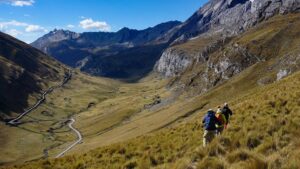Climbing the Ojos del Salado (6,893m) is undoubtedly a dream destination for every mountain lover. This expedition to the highest volcano on earth and takes us into the most remote areas of the Chilean Altiplano through a largely unexplored area of the Andean Atacama High Desert. Nowhere else on the continent is there such a concentration of over 6,000 meters peaks
Route
Region
Duration
Dates
Price
PHYsical level
Technical level
Altitude
Security


Expedition Itinerary
Ready for the adventure?
DAY 1: Arrival
DAY 2: Caldera/Bahía Inglesa – Salar de Pedernales (3383m)
DAY 3: Ascent Volcano Doña Inés (5.075m)
DAY 4: Salar de Pedernales – Salar de Maricunga – Copiapó base camp
DAY 5: Ascent of Cerro Siete Hermanos (4,850m) – Copiapó base camp
DAY 6: Copiapó volcano (6,052m)
DAY 7: Copiapó Base Camp – Laguna Verde
DAY 8: Ascent of Tres Cruces Norte (6,030m)
DAY 9: Rest day
DAY 10: Laguna Verde – Refugio Atacama – Refugio Tejos – Laguna Verde
DAY 11: Laguna Verde – Atacama Refuge
DAY 12: Refugio Atacama – Refugio Tejos
DAY 13: Ascent of Ojos del Salado (6,893m)
DAY 14: Reserve day
DAY 15: Reserve day
DAY 16: Laguna Verde – Pan de Azúcar National Park
DAY 17: Pan de Azúcar – Copiapó Airport – Departure
difficulty level
Physical requirement
Technical level
Easy
Medium
Hard
Expert
expedition season
Jan
Apr
Aug
Dec
What IS includeD?
Mountain guide
Experienced and multilingual mountain guide (Spanish, English, German)
Hotel
3 – 4* Hotels.
Security
Safety and emergency equipment: radio equipment, satellite phone, oxygen, emergency medicine, all permits for the expedition.
Transfers
Private vehicles (Toyota Hilux 4×4 or similar) throughout the Expedition.
Food
1 cook throughout the expedition.
not included
Not included
- National and international flights.
- Personal travel insurance.
- Any additional costs incurred for program changes due to exceptional circumstances (eg extreme weather, natural disasters, strikes, etc.).
- Any additional costs incurred due to the participant’s request.
- Program changes.
- Porters.
- Drinks in hotels/restaurants.
- Personal excess baggage charges.
- Any additional costs incurred due to the participant’s request program changes.
- Individual supplement in hotels/pensions.
- Individual occupancy in double tents.
- Tips.
- Personal Equipment (See recommended equipment).
- Any other service not included in the program.












